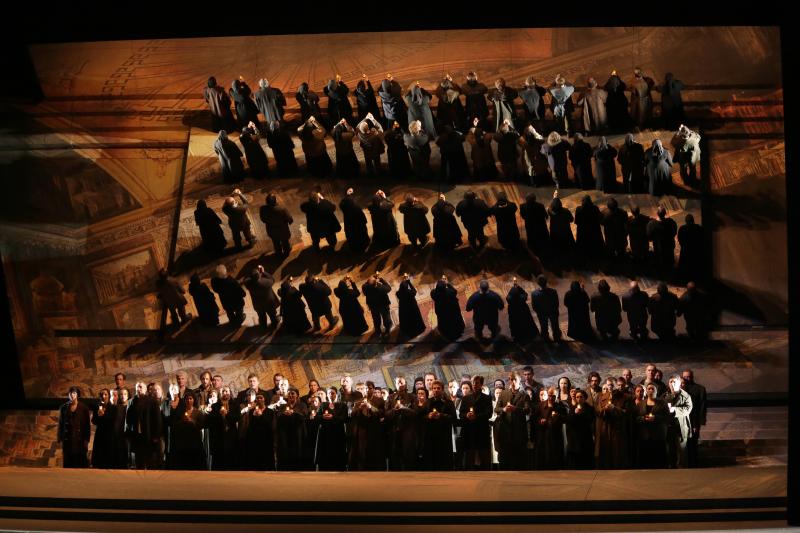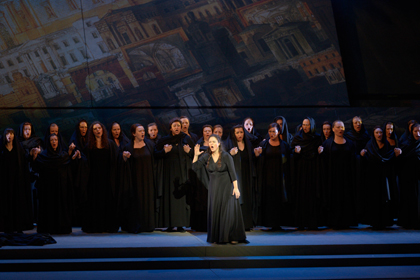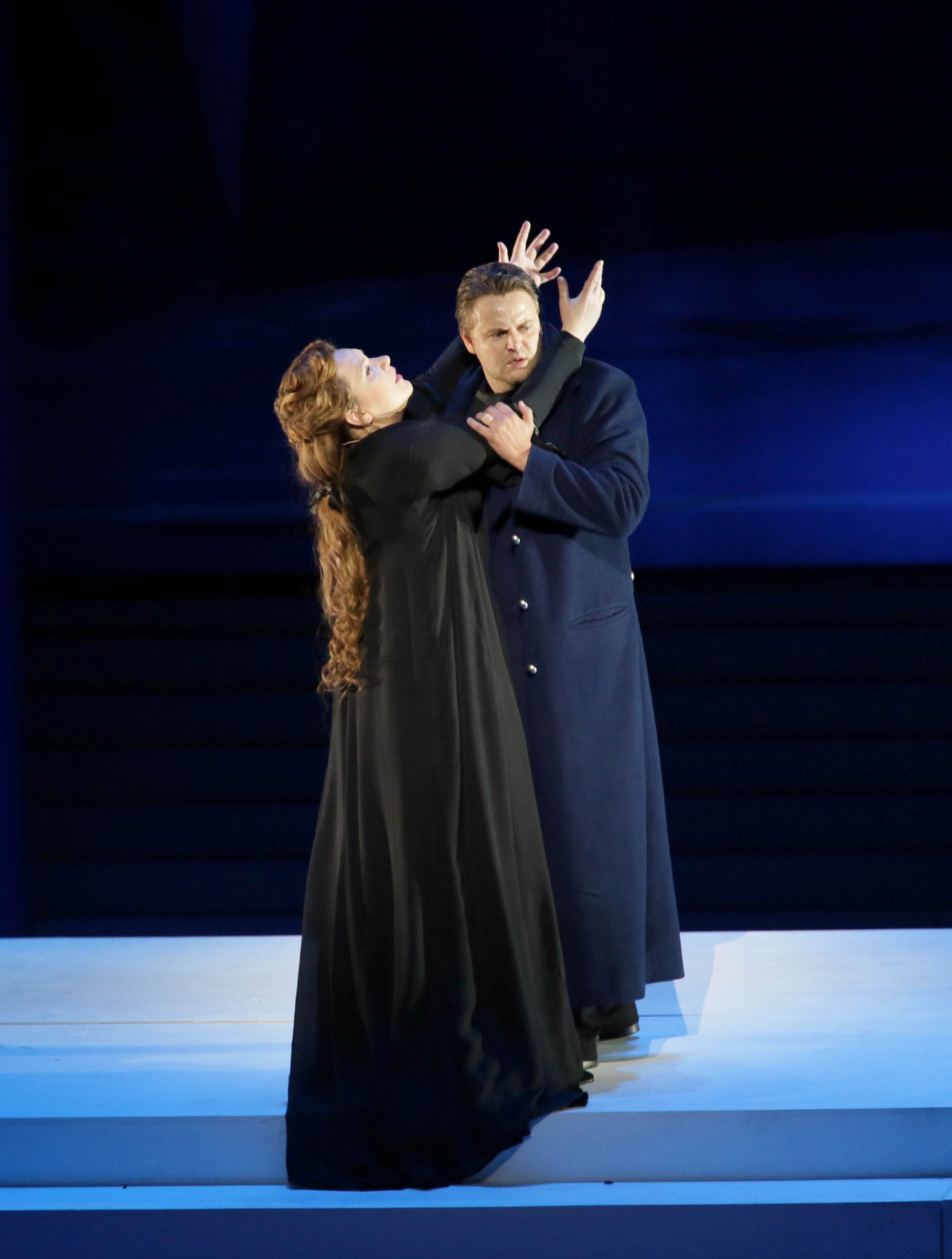Les Troyens, Mariinsky Opera, Gergiev, Festival Theatre, Edinburgh | reviews, news & interviews
Les Troyens, Mariinsky Opera, Gergiev, Festival Theatre, Edinburgh
Les Troyens, Mariinsky Opera, Gergiev, Festival Theatre, Edinburgh
Russian stars bring rich operatic highlight to last week of Edinburgh Festival

The Edinburgh Festival reserved its biggest operatic event for last. From St Petersburg, the Mariinsky Opera brought a production of Berlioz’s Les Troyens that could truly be described as epic: a stellar cast, a vast trompe d’oeil set, and an overall duration comfortably over five hours. A large audience greeted it enthusiastically, but not ecstatically. Maybe exhaustion had set in: there were yawns and smiles in equal measure on the way out.
Les Troyens is really two operas. In the first two acts Troy falls to the Greeks after the naïve defenders ignore the prophecies of doom from Cassandra and drag the Trojan horse into the city. After the long supper interval the action moves to Carthage: in an opera that has been more often cut than not, the three acts of Les Troyens à Carthage can be performed on their own – Berlioz composed a prelude specially. They tell of the arrival of Aeneas, his love for Dido, and his compulsion to abandon her to fulfil his divine destiny, which is to create a new country called Italy.
From the outset, this production is on a grand scale. The first two acts and the last have a set, designed by stage director Yannis Kokkos, that is defined by a huge reflective surface that angles up steeply from the back of the stage. The effect is that the audience not only sees the singers from the front but also from above. The chorus effectively doubles in size and any antics on the stage floor become a simultaneous backdrop. It is not a glass mirror, or even a rigid surface (occasionally it rippled) but for the most part the reflection from the screen is so perfect it is quite difficult to see where reality stops and the reflection begins. The screen was also visually porous so that images of Troy burning could be projected behind it.
 It is clever, but unsettling, and slightly distracts from the magnificent attempts of Cassandra - sung by Mlada Khudoley at short notice - to avert disaster (Cassandra with the women's chorus pictured right). Her voice alone could do it, but her acting is less convincing. For good movement on stage we have to look at the extended ballet episodes. Ladies in the audience (I was told on good authority) particularly liked the half-naked muscular young men who fight and pirouette. The great octet and chorus in scene two, however, shows just what a great and moving sound conductor Valery Gergiev can produce with his orchestra, soloists, and a large chorus.
It is clever, but unsettling, and slightly distracts from the magnificent attempts of Cassandra - sung by Mlada Khudoley at short notice - to avert disaster (Cassandra with the women's chorus pictured right). Her voice alone could do it, but her acting is less convincing. For good movement on stage we have to look at the extended ballet episodes. Ladies in the audience (I was told on good authority) particularly liked the half-naked muscular young men who fight and pirouette. The great octet and chorus in scene two, however, shows just what a great and moving sound conductor Valery Gergiev can produce with his orchestra, soloists, and a large chorus.
Les Troyens à Carthage has simpler, smaller, stage machinery. Carthage looks a bit like an architect’s model and the Trojan fleet is represented by cut-out white ships dangling from strings. But Act IV opens with a magnificent otherworldly representation of Dido’s gardens, which behind multiple gauze screens become a huge rustling northern pine forest in which odd shapes glow and horses fleetingly appear.
 At about this point in the opera the emphasis switches, imperceptibly, from affairs of state to those of love. Aeneas and Dido are getting on so well that the minister Narbal warns of disaster in a great aria just perfect for the sock-trembling bass Yury Vorobiev. But the music soars heavenward and before long the lovers have the wonderful duet “night of endless ecstasy” where Ekaterina Semenchuk’s richly voiced Dido and finds a marginally more acidic counterpoint in Sergey Semishkur’s Aeneas (pictured with Semenchuk). But, even in a heavily stylised production, the acting is unconvincing – far too many hands waved in the air and clasped to the ear.
At about this point in the opera the emphasis switches, imperceptibly, from affairs of state to those of love. Aeneas and Dido are getting on so well that the minister Narbal warns of disaster in a great aria just perfect for the sock-trembling bass Yury Vorobiev. But the music soars heavenward and before long the lovers have the wonderful duet “night of endless ecstasy” where Ekaterina Semenchuk’s richly voiced Dido and finds a marginally more acidic counterpoint in Sergey Semishkur’s Aeneas (pictured with Semenchuk). But, even in a heavily stylised production, the acting is unconvincing – far too many hands waved in the air and clasped to the ear.
Les Troyens contains much beautiful music, here wonderfully performed, but the scope of Berlioz’s invention is not quite equal to the scale of his creation, and there are moments when one realises why full a full staging is still a relative rarity. Writing about the opera, the 19th Century critic Pierre Scudo said: “If he has failed, he has failed magnificently”.
- Further performances 29th and 30th August (different cast on 29th)
Add comment
The future of Arts Journalism
You can stop theartsdesk.com closing!
We urgently need financing to survive. Our fundraising drive has thus far raised £49,000 but we need to reach £100,000 or we will be forced to close. Please contribute here: https://gofund.me/c3f6033d
And if you can forward this information to anyone who might assist, we’d be grateful.

Subscribe to theartsdesk.com
Thank you for continuing to read our work on theartsdesk.com. For unlimited access to every article in its entirety, including our archive of more than 15,000 pieces, we're asking for £5 per month or £40 per year. We feel it's a very good deal, and hope you do too.
To take a subscription now simply click here.
And if you're looking for that extra gift for a friend or family member, why not treat them to a theartsdesk.com gift subscription?
more Opera
 La bohème, Opera North review - still young at 32
Love and separation, ecstasy and heartbreak, in masterfully updated Puccini
La bohème, Opera North review - still young at 32
Love and separation, ecstasy and heartbreak, in masterfully updated Puccini
 Albert Herring, English National Opera review - a great comedy with depths fully realised
Britten’s delight was never made for the Coliseum, but it works on its first outing there
Albert Herring, English National Opera review - a great comedy with depths fully realised
Britten’s delight was never made for the Coliseum, but it works on its first outing there
 Carmen, English National Opera review - not quite dangerous
Hopes for Niamh O’Sullivan only partly fulfilled, though much good singing throughout
Carmen, English National Opera review - not quite dangerous
Hopes for Niamh O’Sullivan only partly fulfilled, though much good singing throughout
 Giustino, Linbury Theatre review - a stylish account of a slight opera
Gods, mortals and monsters do battle in Handel's charming drama
Giustino, Linbury Theatre review - a stylish account of a slight opera
Gods, mortals and monsters do battle in Handel's charming drama
 Susanna, Opera North review - hybrid staging of a Handel oratorio
Dance and signing complement outstanding singing in a story of virtue rewarded
Susanna, Opera North review - hybrid staging of a Handel oratorio
Dance and signing complement outstanding singing in a story of virtue rewarded
 Ariodante, Opéra Garnier, Paris review - a blast of Baroque beauty
A near-perfect night at the opera
Ariodante, Opéra Garnier, Paris review - a blast of Baroque beauty
A near-perfect night at the opera
 Cinderella/La Cenerentola, English National Opera review - the truth behind the tinsel
Appealing performances cut through hyperactive stagecraft
Cinderella/La Cenerentola, English National Opera review - the truth behind the tinsel
Appealing performances cut through hyperactive stagecraft
 Tosca, Royal Opera review - Ailyn Pérez steps in as the most vivid of divas
Jakub Hrůša’s multicoloured Puccini last night found a soprano to match
Tosca, Royal Opera review - Ailyn Pérez steps in as the most vivid of divas
Jakub Hrůša’s multicoloured Puccini last night found a soprano to match
 Tosca, Welsh National Opera review - a great company reduced to brilliance
The old warhorse made special by the basics
Tosca, Welsh National Opera review - a great company reduced to brilliance
The old warhorse made special by the basics
 BBC Proms: The Marriage of Figaro, Glyndebourne Festival review - merriment and menace
Strong Proms transfer for a robust and affecting show
BBC Proms: The Marriage of Figaro, Glyndebourne Festival review - merriment and menace
Strong Proms transfer for a robust and affecting show
 BBC Proms: Suor Angelica, LSO, Pappano review - earthly passion, heavenly grief
A Sister to remember blesses Puccini's convent tragedy
BBC Proms: Suor Angelica, LSO, Pappano review - earthly passion, heavenly grief
A Sister to remember blesses Puccini's convent tragedy
 Orpheus and Eurydice, Opera Queensland/SCO, Edinburgh International Festival 2025 review - dazzling, but distracting
Eye-popping acrobatics don’t always assist in Gluck’s quest for operatic truth
Orpheus and Eurydice, Opera Queensland/SCO, Edinburgh International Festival 2025 review - dazzling, but distracting
Eye-popping acrobatics don’t always assist in Gluck’s quest for operatic truth

Comments
A wonderful evening, with
Saw this on its third and